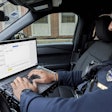You and some fellow officers are serving a warrant on a drug dealer. As you enter the suspect's backyard, he unleashes his pit bull with the command, "Attack!" The powerful animal lunges toward you with fierce determination and snarling teeth.
You have no choice. You draw your service weapon and fire three rounds into the dog. Two find their mark in its chest cavity, while the third rips through one of its front legs. It takes a few more paces, collapses, and dies.
This is not a far-fetched scenario. Pit bulls, rottweilers, dobermans, and other attack dogs have become part of the street criminal's arsenal. They represent a real danger to law enforcement officers. And you need to know how to deal with them.
The first thing you need to realize is that you have to conquer your fear. A dog attack can be controlled, but if you panic and let fear take over and try to turn and run in an attempt to avoid a bite, a dog will run you down.
Now, don't get me wrong, there are times when turning and running is your best option. If the dog is half a block away and you're standing close to your patrol car, there's nothing wrong with jumping into your cruiser to avoid a bite or to avoid having to shoot the animal.
Unfortunately, you may not have the option of retreating. You may have to stand and fight.
Making a Stand
The first thing you have to realize is you're not dealing with a friendly, old puppy dog. Man's best friend is a wonderful creature, but it's also an animal. Worse, it's a predatory animal. That means that when a dog attacks, its instinct is that of a predator, and the way to prevent serious injury and even death is to acknowledge and respect that instinct.
Never turn your back on a predator in close quarters. If you turn and run, you become nothing more than prey. Instead, face the animal squarely and bend your knees to lower your center of gravity.
Once you're in position, start yelling at the animal as you face it. An attacking dog is expecting you to turn and run. When you face it and act aggressively toward it, you may scare it off. Unfortunately, a trained or determined animal will not be swayed by this tactic.
Regardless of whether the dog is a trained attack dog at the command of a bad guy, or a suddenly irritated and aggressive family pet, be careful about cornering or trapping it. Always give an animal a way out or a way to retreat. Trapping a dog in a corner and leaving him with no other option but to fight his way out is a sure way to get bitten.
If you find you have trapped a dog in a corner, keep facing the dog and slowly start to back away, giving it an escape route. This tactic will work on most dogs that are not committed to the attack but are instead reacting out of fear.
A determined animal who is on the attack and committed to the bite is another story. It's made up its mind to attack you and is actively charging you, and it won't back down.
OC Spray
A determined dog can only be deterred with force. Which means you need to decide between OC spray and deadly force. OC is sometimes a viable option, but its execution can be tricky and its results can be unpredictable.
For example, if you do decide to use OC on a dog, it is imperative that you leave it an escape route. If you don't, then you will get bitten as the dog tries to fight his way past you. Remember, even a dog that wasn't committed to the attack will fight to get away from you and the effects of the OC when trapped.
Also, keep in mind that just as OC spray does not work on all humans, it won't work on all canines. Dogs that have committed to an attack and trained or conditioned dogs won't be fazed by pepper spray any more than a human PCP user. Worse, even if a dog is susceptible to the pain of OC, it can cover a lot of ground before the spray has time to take effect.[PAGEBREAK]
Taking the Bite
As we've discussed, dogs are meat eaters and their instinct is to hunt and kill. A dog kills in the wild by grabbing its prey with a bite, pulling it down, and tearing out its throat. And that's exactly what an attacking dog will try to do to you. Your survival depends on using the dog's instinct against it.
First, face the animal squarely in a low-center-of-gravity stance with your knees slightly bent and your non-shooting arm extended. Most dogs will bite the body part that's closest to them unless they have been specifically trained to do otherwise. Even then, training has a hard time overriding the animal's instincts. By presenting the dog with your non-shooting arm to bite, you can take control of the attack.
When you are braced, draw your pistol and prepare yourself for the counterattack. Make sure you have a safe background for shooting before you fire any rounds toward the charging animal. If you do not have a safe background to shoot the dog as it's charging you, then you will have to take the bite.
Once the animal clamps down on your arm, you can turn to try and maneuver it into a better position for shooting. Just make sure you stay on your feet. In the case of a larger dog such as a 130-pound rottweiler, it will be very difficult for you to maneuver the animal. A dog has four legs and runs every day and a large dog is a strong dog, so it will be difficult to handle and turn.
When you don't have a safe background for shooting and cannot maneuver the animal, then you can shoot in a downward position using the ground as a safe backstop. Once the dog latches onto your non-shooting arm, raise your weapon up over the top of the dog and fire into it from a downward position angled out away from yourself, using the ground as your backstop.
Try to aim for the dog's shoulder. This will allow you to hit some of its major organs and blood vessels. At the very least you'll break its shoulder, which will lessen the dog's mobility and slow it down to give you a better shot.
You might think that a headshot is the way to go in this situation, but that can be a very bad option. Remember, the animal's head is latched onto your arm via its teeth. Further, the dog's head is going to be thrashing about in its attempt to drag you down, so there's a good chance you'll miss or your weapon will be knocked around. In addition, as you raise the weapon toward the animal's head, there is a chance it will let go of your non-shooting arm and latch onto your shooting arm or hand. And finally, just as with human targets, a dog's head is smaller than its body and therefore harder to hit.
Working Out
In the academy you were sprayed with OC to teach you that you can fight through its effects. So, too, you should experience a bite from a police K-9 to show you that you can fight through a dog attack. You need to learn that a dog attack can be controlled.
You need to train and be prepared for any possible attack and that includes a canine assault. Whether it's an intentional assault by a trained dog or a family pet that's gone bad, you need to know how to respond appropriately to this threat. You would never want to be forced to shoot someone's pet, but the threat from these animals is real and your response must be appropriate.
Stopping an Attacking Dog
√ Lower your center of gravity by bending your knees.
√ Yell at the dog.
√ Spray it with OC.
√ If you can do so safely, shoot the dog before it bites you.
√ When you can't shoot the dog before it bites, control the attack by making the dog bite your weak side arm.
√ Do everything you can to stay on your feet.
√ Shoot the dog in the chest or shoulder until it releases you.
The Pit Bull Drill
Another way to train for a dog attack is to use the "pit bull drill." To perform this cheap and simple shooting drill, take a two-liter soda bottle and fill it with water. Place the cap back on the bottle and tie a piece of cord, (clothes line works great), around the neck of the bottle.
You now have a "pit bull." Well, at least you have a target that
approximates the chest cavity area of a pit bull.
To perform the pit bull shooting drill, throw the bottle down range approximately 25 to 35 feet with the other end of the cord running in between the shooter's feet. Now, have a volunteer stand behind you and pull the cord.
Don't draw your weapon until the bottle starts to move. When given the command the volunteer will quickly pull on the cord, which will move the bottle toward you even faster. Shoot until you strike the bottle, releasing the water. The exercise is not over until the bottle is empty, or the firearms instructor stops the exercise.
For safety reasons, make sure your volunteer stops pulling the bottle when it gets to about five feet out from the shooter.
Michael T. Rayburn is a 24-year veteran of Law Enforcement and the author of "Advanced Vehicle Stop Tactics" and "Advanced Patrol Tactics." The books and his video "Instinctive Point Shooting with Mike Rayburn" are available through www.calibrepress.com.














